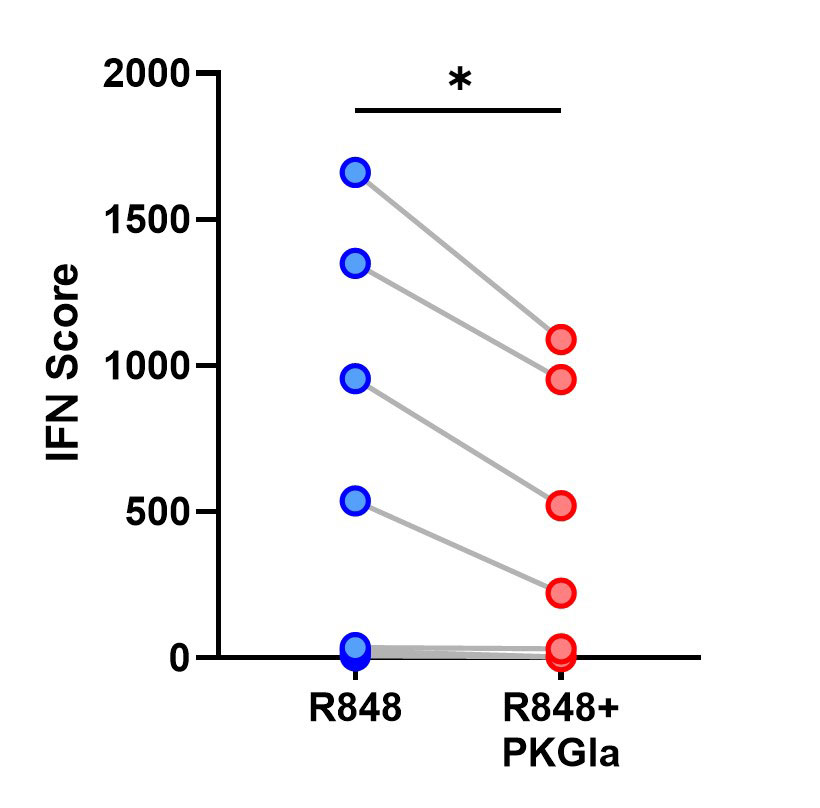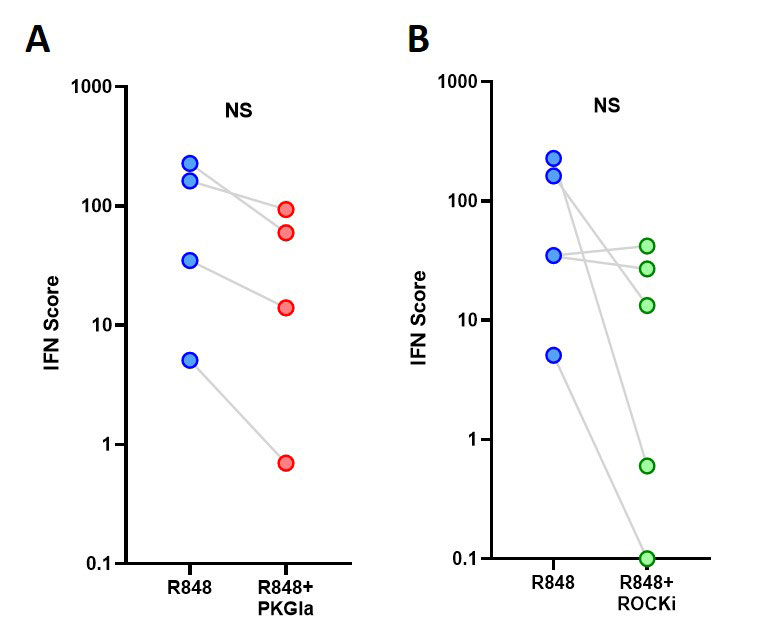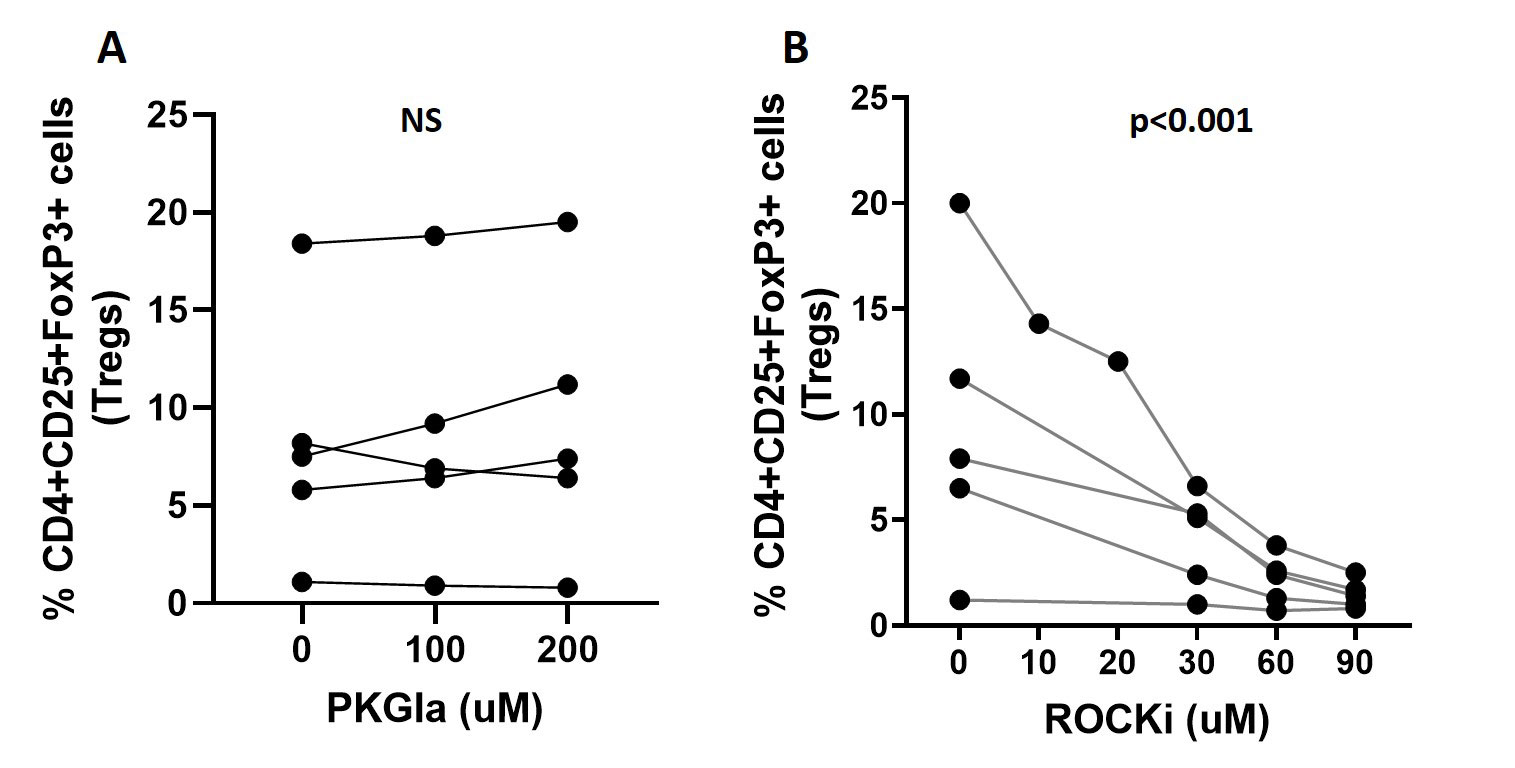Session Information
Session Type: Poster Session B
Session Time: 9:00AM-10:30AM
Background/Purpose: IFNα is a pathogenic factor in SLE. The PRKG1 rs7897633 variant has been previously identified as the top hit in European ancestry patients with SLE and high IFNα compared to those with low circulating IFN levels. PRKG1 codes for the cGMP-dependent protein kinase I (PKGI). Activation of PKGI is thought to lead to the inhibition of RhoA and Rho-associated kinases (ROCK). The RhoA/ROCK pathway plays critical roles in autoimmunity, at least in part by modulating type I IFN production and the function of Th17 and Treg cells. However, the two isoforms of ROCK (1 and 2) may have divergent effects, which could hinder the use of non-selective ROCK inhibitors as therapeutic agents in autoimmunity. Moreover, whether PKGI activation also modulates IFN production and impacts Treg numbers and function is unknown. Accordingly, we evaluated the effect of PKGI stimulation and ROCK inhibition on type I IFN production and Treg cell frequency.
Methods: PBMCs from 10 healthy adult subjects were isolated by Ficoll-Hypaque density gradient centrifugation. For IFN production, we also used B lymphoblastoid cell lines (LCL) derived from healthy subjects (Coriell repositories). To assess type I IFN production, PBMCs and LCLs were treated with R848 +/- the PKGI agonist (PKGIa) 8-CPT-cGMP or the pan-ROCK inhibitor (ROCKi) Y27632 (PBMCs only), and supernatants were collected after 16-18 hours. WISH cells were incubated with the PBMC and LCL supernatants for 6 hours, after which canonical type I IFN-induced gene expression was measured by RTqPCR, standardized to healthy controls, and summed to generate a type I IFN score. For Treg analyses, PBMCs were incubated with plate-bound anti-CD3 for T cell expansion in the presence of the PKGIa or the ROCKi. On day 7, PBMCs were stained with fluorochrome-conjugated antibodies for cell surface markers and FoxP3, and analyzed by flow cytometry. Lymphocytes were gated based on light scattering properties and dead cells were excluded using the Zombie UVTM Fixable viability dye. Percentages of Treg (CD4+CD25+FoxP3 cells) were referred to the CD3+CD4+ T cells. Statistically significant differences were determined by the Wilcoxon matched-pairs signed-rank test or sum-of-squares F test, as appropriate.
Results: PKGI stimulation with 8-CPT-cGMP reduced R848-induced type I interferon production by LCLs (Fig.1). In PBMCs, there was a trend towards lower type I IFN production in cells pre-treated with the PKGIa and the ROCKi (Fig.2A-B). However, these findings did not reach statistical significance. The percentage of Tregs did not change in PBMCs treated with increasing doses of the PKGIa 8-CPT-cGMP (Fig.3A). In contrast, there was a significant dose-dependent decrease in Treg percentages with increasing doses of the ROCKi Y27632 (Fig.3B; p< 0.001).
Conclusion: PKGI stimulation decreases TLR7/8-induced type I IFN production and does not impact Treg expansion. These novel findings suggest a potential beneficial effect of enhancing PKGI activity which could have therapeutic implications in type I IFN-driven autoimmune diseases, such as SLE. In contrast, non-selective ROCK inhibition is associated with a dose-dependent decrease in Treg frequencies, which could limit their therapeutic benefit in autoimmunity.
To cite this abstract in AMA style:
Fernandez Ruiz R, Nln I, Paredes J, Niewold T. Modulation of Type I IFN Production and Regulatory T Cells by the PKGI/ROCK Signaling Pathway [abstract]. Arthritis Rheumatol. 2022; 74 (suppl 9). https://acrabstracts.org/abstract/modulation-of-type-i-ifn-production-and-regulatory-t-cells-by-the-pkgi-rock-signaling-pathway/. Accessed .« Back to ACR Convergence 2022
ACR Meeting Abstracts - https://acrabstracts.org/abstract/modulation-of-type-i-ifn-production-and-regulatory-t-cells-by-the-pkgi-rock-signaling-pathway/



